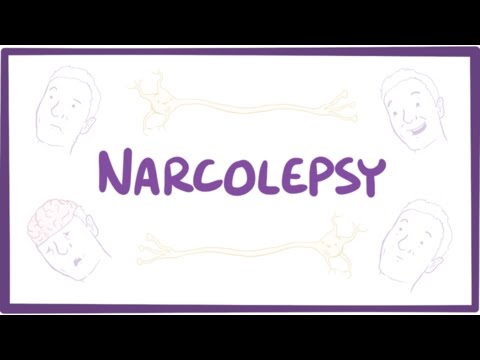At one time or another you’ve probably had to force yourself to stay awake, maybe while driving or when you’re in a looong lecture. In these situations, you were exerting control over your sleep-wake cycles. Narcolepsy is a disorder in which individuals lose the ability to regulate these sleep-wake cycles, so the normal boundary between sleeping and being awake is blurred, and that leads to characteristics of sleeping happening while a person is awake. In the brain, there are a special group of neurons that help increase the state of wakefulness, and they extend from the lateral hypothalamus to various parts of the brain like the reticular activating system (or RAS). In individuals with narcolepsy, there are fewer of these excitatory neurons, and each neuron carries less of the neuropeptides orexin A and B (also called hypocretin 1 and hypocretin 2). These orexins increasing the activity of wake-promoting regions of the brain, thereby tipping the scales in favor of wakefulness and preventing inappropriate transitions into a sleeping state.
With narcolepsy, it’s thought that an autoimmune process might damage the neurons delivering orexin or that there may be some other direct injury to those neurons. Either way, when that happens, less orexin is sent out and sleep-related symptoms begin to intrude into wakefulness. The onset of narcolepsy often happens during adolescence and young adulthood, and is classically associated with four key symptoms. The first is daytime sleepiness, where people chronically feel sleepy.
They can get sleep attacks where they doze off with little warning, sometimes inappropriately, but they generally don’t sleep more than healthy people in a given 24 hour period. Most individuals with narcolepsy find that a short, 15-minute nap substantially improves their alertness for a few hours, which suggests that the sleepiness of narcolepsy is caused by a problem with the brain circuits that normally promote full alertness, rather than poor quality or insufficient sleep. Normally when a healthy person goes to bed, they go through a sleep cycle lasting an hour or more before they reach REM sleep, which is the stage of sleep that is characterized by dreaming. People with narcolepsy fall asleep very quickly, in as little as five minutes, and they often go directly into REM sleep. This results in their having very vivid dreams, even when they fall asleep for brief periods of time. Alright the second symptom that often develops over time is cataplexy which is when some strong emotion, which can be a positive one like laughter or a negative one like anger, triggers a transient muscle weakness.
That muscle weakness is often partial, affecting the face, neck, and knees, but severe episodes can cause total body weakness or paralysis, causing the person to collapse. These people are usually conscious during cataplexy, and the weakness they feel usually resolves within minutes. Understandably, this symptom can have a severe impact on the lives of people with narcolepsy, both from a physical (since they could get hurt when they collapse) as well as a psychological perspective. The fear of cataplexy and having an episode in public can lead to extreme anxiety, and will often lead to these people to avoid situations that they believe might elicit an episode. The third symptom is having hypnagogic hallucinations which are vivid, often frightening visual, tactile, or auditory hallucinations that occur as the patient is falling asleep.
They probably result from a mixture of wakefulness and the dreaming of REM sleep. Hypnopompic hallucinations are similar except that they occur upon awakening; although these are less common, they can happen in narcolepsy. Okay so the final key symptom is sleep paralysis, which is the complete inability to move for a few moments to a few minutes immediately after awakening or just before falling asleep. This is because during REM sleep the brain is very active, but the voluntary muscles of the body are generally paralyzed, probably to prevent an injury related to a dream about running or flying. This paralysis generally subsides as we start to wake up, but occasionally we regain consciousness before the paralysis has worn off. Episodes of sleep paralysis can be even more frightening because the immobility might be accompanied by hypnopompic hallucinations or a sensation of suffocation. Interestingly, only a minority of people with narcolepsy experience all four symptoms, which can make diagnosis difficult or make it easy to get confused with other sleeping disorders. Evaluations like polysomnography or a multiple sleep latency test, both of which take physiologic measurements like EEG and ECG tracings, while a person is sleeping, can be used to help diagnose narcolepsy.
For treatment, while there is no cure for narcolepsy, there are a number of medications including specific stimulants and antidepressants that can be used to help manage many of the symptoms. Alright, so to recap, in narcolepsy there is a lack of orexin which is a neuropeptide that normally helps maintain a state of wakefulness. In its absence, many phenomena normally associated with sleep begin to affect the waking state causing symptoms like daytime sleepiness, cataplexy, hypnagogic hallucinations, and sleep paralysis. Thanks for watching, you can help support us by donating on patreon, or subscribing to our channel, or telling your friends about us on social media..
